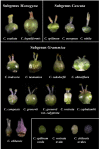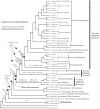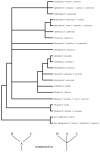Systematics and plastid genome evolution of the cryptically photosynthetic parasitic plant genus Cuscuta (Convolvulaceae)
- PMID: 18078516
- PMCID: PMC2242782
- DOI: 10.1186/1741-7007-5-55
Systematics and plastid genome evolution of the cryptically photosynthetic parasitic plant genus Cuscuta (Convolvulaceae)
Abstract
Background: The genus Cuscuta L. (Convolvulaceae), commonly known as dodders, are epiphytic vines that invade the stems of their host with haustorial feeding structures at the points of contact. Although they lack expanded leaves, some species are noticeably chlorophyllous, especially as seedlings and in maturing fruits. Some species are reported as crop pests of worldwide distribution, whereas others are extremely rare and have local distributions and apparent niche specificity. A strong phylogenetic framework for this large genus is essential to understand the interesting ecological, morphological and molecular phenomena that occur within these parasites in an evolutionary context.
Results: Here we present a well-supported phylogeny of Cuscuta using sequences of the nuclear ribosomal internal transcribed spacer and plastid rps2, rbcL and matK from representatives across most of the taxonomic diversity of the genus. We use the phylogeny to interpret morphological and plastid genome evolution within the genus. At least three currently recognized taxonomic sections are not monophyletic and subgenus Cuscuta is unequivocally paraphyletic. Plastid genes are extremely variable with regards to evolutionary constraint, with rbcL exhibiting even higher levels of purifying selection in Cuscuta than photosynthetic relatives. Nuclear genome size is highly variable within Cuscuta, particularly within subgenus Grammica, and in some cases may indicate the existence of cryptic species in this large clade of morphologically similar species.
Conclusion: Some morphological characters traditionally used to define major taxonomic splits within Cuscuta are homoplastic and are of limited use in defining true evolutionary groups. Chloroplast genome evolution seems to have evolved in a punctuated fashion, with episodes of loss involving suites of genes or tRNAs followed by stabilization of gene content in major clades. Nearly all species of Cuscuta retain some photosynthetic ability, most likely for nutrient apportionment to their seeds, while complete loss of photosynthesis and possible loss of the entire chloroplast genome is limited to a single small clade of outcrossing species found primarily in western South America.
Figures








References
-
- Yuncker TG. The genus Cuscuta. Mem Torrey Bot Soc. 1932;18:113–331.
-
- Engelmann G. Systematic arrangement of the species of the genus Cuscuta, with critical remarks on old species and descriptions of new ones. Trans Acad Sci St Louis. 1859;1:453–523.
-
- Choisy JD. De Convolvulaceis Dissertatio Tertia. Mem Soc Phys Hist Nat Geneve. 1841;9:261–288.
-
- Kuijt J. Biology of Parasitic Flowering Plants. Berkeley and Los Angeles: University of California Press; 1969.
-
- Hibberd JM, Bungard RA, Press MC, Jeschke WD, Scholes JD, Quick WP. Localization of photosynthetic metabolism in the parasitic angiosperm Cuscuta reflexa . Planta. 1998;205:506–513. doi: 10.1007/s004250050349. - DOI
Publication types
MeSH terms
Substances
LinkOut - more resources
Full Text Sources
Molecular Biology Databases
Miscellaneous

